HUNTING ANIMALS
in Slovakia

Red Deer (Cervus elephaus)
| Hunting Season: | Stag(Male): 16.8. – 15.1. |
Hind (Female): 16.8. – 30.11. |
Roe-kid (Young): 16.8. – 15.1. |
| Mating Season – Red deer pairing season: | approx.: 10.9. – 15.10. |
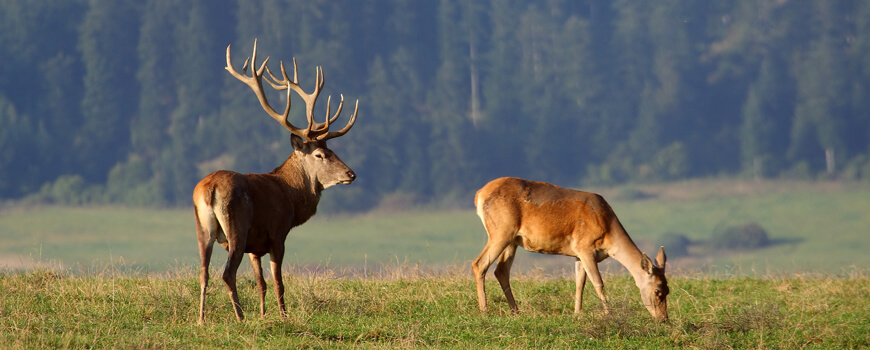
The Red Deer lives in the entire territory of our country. It favours broad-leaved and mixed forests also meadows. Nowadays the number of deer in our country is estimated to be around 40,000. In our territory we register two kinds of forest deer. On the east side of Slovakia, we have the Carpathian deer and on the west side of Slovakia lives the Middle-European deer. In central Slovakia we often have crossbreeds of these two individuals. The length of the Carpathian deer’s body can reach up to 2-2.5 meters and the wither height of it goes up to 150 cm’s. Its weight can vary from 150 to 250 kg’s. On the other hand, the Middle-European deers weight varies from 120 to 160 kg. The hind is about one third smaller than the stag. The red deer lives in herds, separately depending on the gender, where the roe-kid is held in the herd of the hinds.
Mating season:
The hunt in this period is accompanied by beautiful experiences, by which the hunters themselves get the goose bumps. The herds of deer start to crumble in August and they start finding their usual mating places to which they are used to every year. Sometimes they rove like that couple of kilometres. The mating starts approximately in the first half of September and lasts for about 4 weeks. The herd of the hinds is led by a fully grown stag and it tries to keep the entire herd together. If any of the hinds move away from the herd the fully grown stag gets her back with repeated strikes by his antlers and also protects the entire herd from any approaching rivals. During the changing of the location of the herd, the herd is led by an old experienced hind and the stag always walks at the end, behind the herd. At this time the stag resounds with deep jugular lowing, which are usually the most intense during cold nights. Experienced hunters know by the lowing of the stag if it is a seeking stag, if it is a main stag that leads the herd, if it is chasing a mating hind, if it calls out a rival for fight or if it just simply rests. Mating season is just simply the most beautiful period in the year of the hunter.
Fallow Deer (Dama dama)
| Hunting Season: | Buck (male): 1.9. – 15.1. | Doe (Female): 16.8. – 31.12 | Fawn (young): 16.8. – 31.12. |
| Mating Season – Fallow deer pairing season: | approx.: 15.10. – 15.11. |
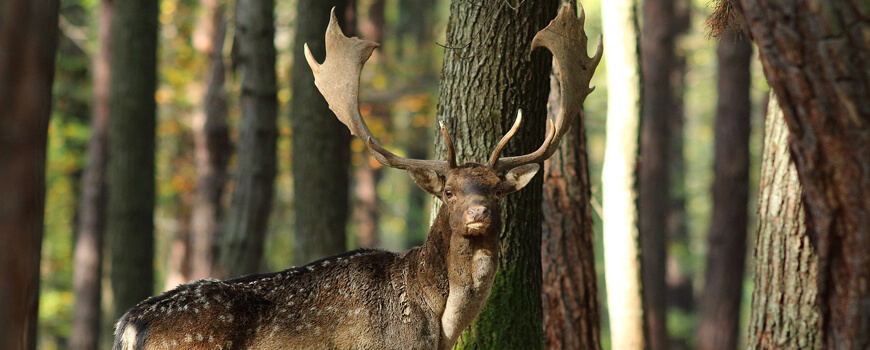
The Fellow Deer’s most favoured locations are the warm broad-leaved or mixed forests at the uplands of South and Central-Slovakia to the height of 600 meters above sea level. The actual number of fallow deer in Slovakia is about 6000. It lives in herds separated based on gender. The fallow deer is smaller than the red deer. The length of its body is about 130 to 165 cm’s. The wither height of it varies from 80 to 110 cm’s and the weight of it varies from 50-90 kg’s. The doe is usually smaller, and their weight varies from 30 to 50 kg. The colour of the fallow deer is usually yellow-reddish with white stains in the longitudinal rows and with a darker band on the back. In the winter the fur of it is grey-brownish, the spottiness retreats or completely disappears. The mating of the fallow deer starts in the first half of October and it last from 3 to 4 weeks. During this time the doe huskily ruts, which can be heard from a 500-meter-long distances. With rutting the doe lures the mating fawns to its own mating ground. At this place the doe excavates trough shaped mating wells, and after this it urinates and rests in them. He protects his own territory from rivals. Younger does move around on the edge of the grown does mating place, and these younger does often fight with each other. The collision of their antlers can be heard within a very long distance. The mating faws are looking for mating places and are choosing the does, which they later mate with. The fallow deer’s mating season is a beautiful hunting experience, accompanied by duels, rough duels of fallow deer, which should not be missed by any passionate hunter.
Mouflon (Ovis musimon)
| Hunting Season: | Ram(male): 1.8. – 15.1. | Ewe (Female): 1.8. – 31.12. | Lamb (Young): 1.8. – 31.12. |
| Mating season– Mouflon pairing season: | approx.: 10.11. – 10.12. |
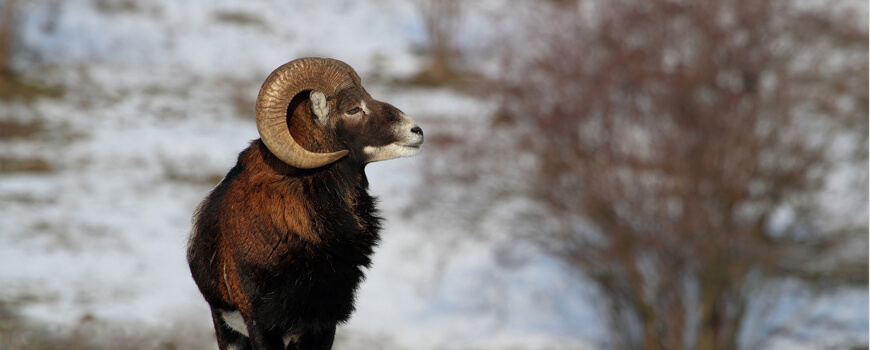
The mouflon is a type of animal, which favours dry mixed forests with rocky lands up to 1000 meters above sea level. Avoids lowland forests with wet grounds and areas with lots of snow. The mouflons strong hoofs conically narrow to the front, which allows them safe movement along rocky lands. The actual number of mouflons in Slovakia is about 8000. The mouflon’s length can reach up to 110-130 cm’s. The wither height of them is about 70-90 cm’s and the weight of them varies from 35-55 kg. The females are smaller and their weight reaches up to maximum of 30 kg. The summer fur of the mouflon is short and rusty brown. The winter fur of the mouflon is thick, darker with a mane under the neck, and also on the body of the mouflon there are shiny white parts. The mating season of the mouflon starts in November and last until December. During cold weathers it starts earlier and in case of warmer weathers it starts later. The older sheep try to control the herd of the ewes, while they also get into hard fights. While they fight, from distances of 20 meters they crash into each other with their horns, and at the same time they try to push one another away from the herd. The crashes of their horns can be heard within long distances. The fight ends when the weaker, completely exhausted mouflon leaves the herd.
Forest Deer (Carpreolus capreolus)
| Hunting Season: | Roe (male): 16.5. – 30.9. | Doe (female): 1.9. – 31.12. | Fawn (young): 1.9. – 31.12. |
| Mating season – Forest deer paring season: | approx.: 15.7. – 15.8. |
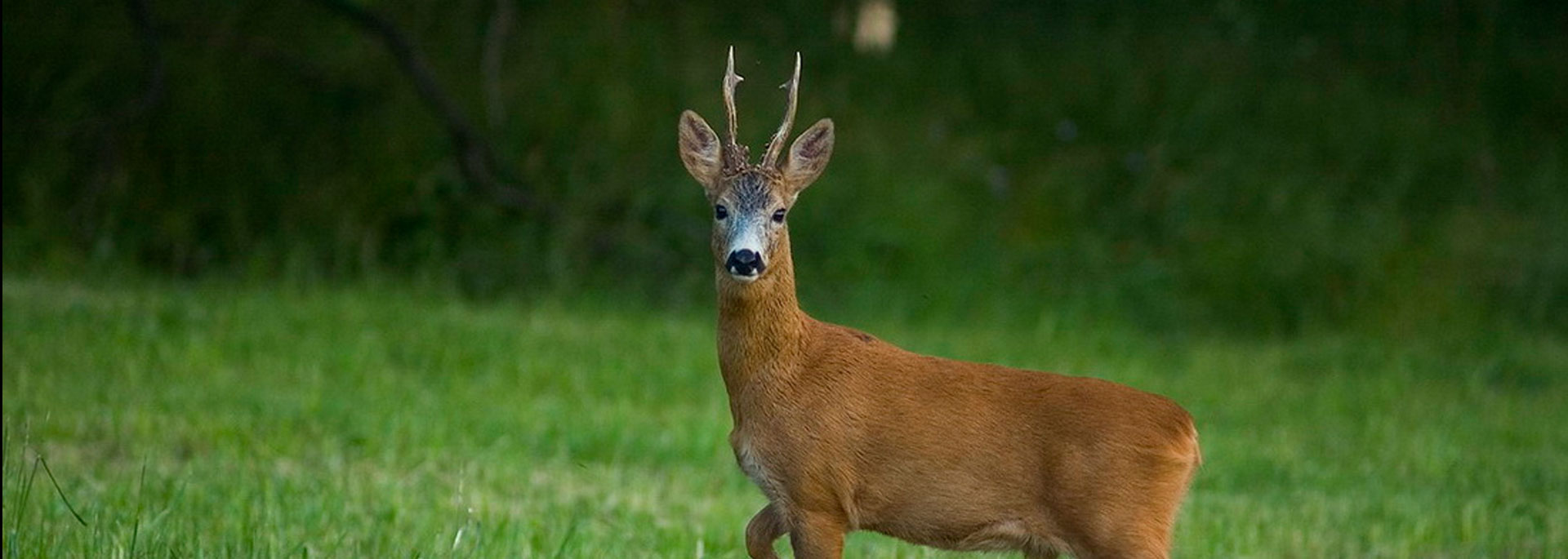
The forest deer is the most widespread cloven-hoofed animal and lives on the entire region of our country. The Forest deer mostly favours broad-leaved and mixed forests with meadows, and adjacent farmlands, where it likes to go on the pasture. The actual number of forest deer in Slovakia is about 8500. The length of the forest deer goes from 90 to 140 cm’s and the height of it goes up to around 85 cm’s. The weight of a fully grown individual is usually around 20-35 kg. The roes are heavier than the does. The summer colouring of the forest deer is yellowish and rusty red. For spring this animal changes its colour quite slowly, usually in May and June. The colour of younger individuals changes more. In October they quickly change their fur to winter fur, which is grey-brownish and also thicker. The roe in the mating season from the first half of July till the first half of August searches for a mating doe on its own territory by their smell in their track of footprints. The roe before mating chases the doe for a long period, which is resounded with a loud and rod whistle. The roe loudly deflates as a reply to the whistle. The mating is really short and often repeated. After the end of the mating, which last about 3 to 5 days, the roe leaves the doe and searches for another mating doe. If any of the does wasn’t inseminated in the summer, it can be still inseminated until November by a roe, which hasn’t thrown down its antlers yet. This happens very rarely though.
Wild Boar (Sus Scrofa)
| Hunting Season: | Boar(male): 16.7. – 31.12. | Sow(female): 16.7. – 31.12. | Young (older than one year): whole year | Piglet(young): whole year |
| Mating Season – Wild boar pairing season: | approx.: 1.11. – 31.12. |
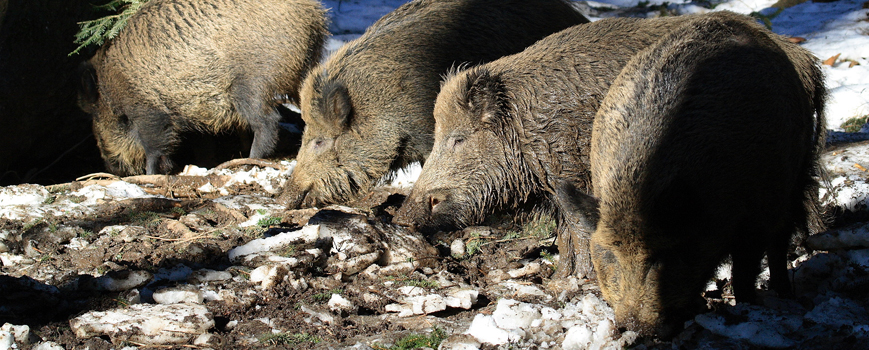
The wild boar mostly favours wet broad-leaved and mixed forest with also adjacent farmlands. It is the most numerous in the lower middle regions of the country, but we can find wild boar higher in the mountains as well. The current number of wild boar in Slovakia is about 30,000. The fully grown wild boars stumpy body’s length reaches up to 180 cm’s and its wither height reaches up to 1 meter. The wild boars weight varies from 100 to 250 kg, sometimes it exceeds even that. The weight of the sows is lower and it varies from 80 to 150 kg. The boar has in his denture well developed canines – tusks, which keep on growing all the time and mutually sharpen over the time. The fur of the wild boar is shorter in the summer and has grey shades. In the winter its bristles are thicker, longer and have a darker blackish shade. Along the boars back the bristles are even longer and create a so called ridge, which bristles when the boar is angry. The wild boars live in family herds. A herd like this is composed of leading sows, which are mutually related to their piglets and to the more than one-year-old youngs. The entire herd, which is composed of about 30 individuals, is led by the oldest sow. The mating season starts from October and quite often last until January. First the old sows start mating, after this the more than one-year-old youngs and in the years of abundance of food even 8-9 months old sows which are left back from spring hunts. Some of the wild sows can mate even in the late spring months. In the time of mating, the boars which until then lived reclusively, start searching for herds of wild sows and start mutual fights between each other, for the mating wild sows. They resound with angry grunts and they chop with their teeth. They mark their own outpost with odorous and frothy spits. The boars during this period don’t eat and many times they lose even about 15% of their weight. The mating lasts for about a minute and is repeated once or twice one after another. The wild sow at the time of mating makes a strange whining noise.
Tatra Chamois(Rupicapra rupicapra tatrica)
| Hunting season: | Chamois 1.9. – 31.12. |
| Mating season – Tatra chamois pairing season | approx.: 1.11. – 30.11. |
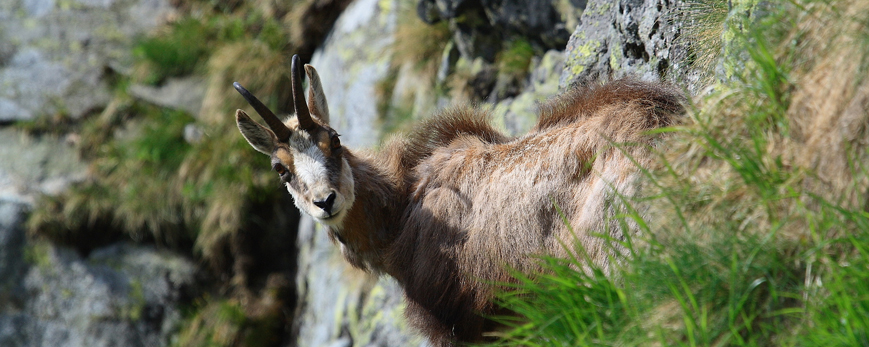
The chamois is an authentic animal of the High Tatras. It lives there exclusively on the rocky ridge above the upper boarder of the forest. The number of them used to be around 1200, but currently their number was calculated up to 370 all together in the entire region of the High Tatras, and on the Polish side of the Tatras around 110. The body of the chamois varies from 110 to 130 cm’s in length. Its height is around 75cm’s and the weight of it varies from 25 to 50 kg’s. The females are always weaker. The colour of its fur in summer is rusty brown with a grey longitudinal strip on the back. The spring time change of their furs colour usually happens in June. The colour of their fur changes to winter fur in October. The dark brown and thick fur creates a warm isolation, which makes it able for the animal to lay on the frosty ground covered with snow. The strong and muscular legs of the chamois makes it able to climb and jump on the rocks. The females live together with the immature young chamois in herds, in the summer in smaller herds and in the winter in bigger herds. The herd is always led by an old experienced female chamois, which warns the others in case of danger with a warning whistle. Fully grown chamois live in smaller groups and the older ones are loners. The mating season of the chamois happens in November. The old males approach the herds of female chamois and they try to control or lead them. Often fights among them take place, which consist of mutual wild chase of each other. They never hit each other head on, but always into the side of the opponent and during a fight they tear and mow with their antlers from the bottom to the top. During mating season, they resound with a strange murmurous noise.
Brown Bear (Ursus arctos)
| Hunting Season: | 1.10. – 30.11. |
| Mating Season – Brown bear pairing Season: | cca 15.6. – 31.7. |
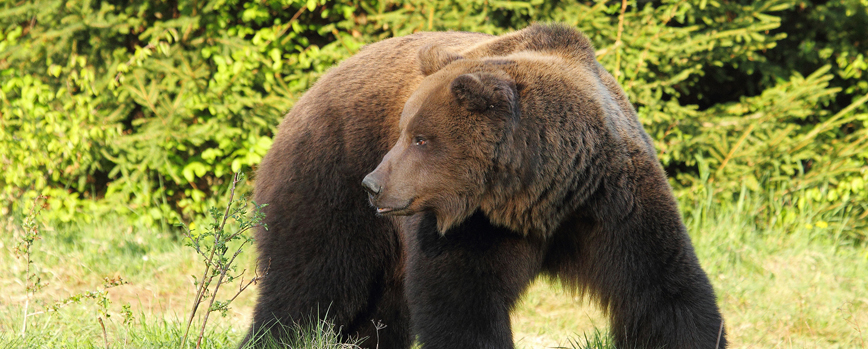
In our country the bear is our biggest beast. The actual number of bears in Slovakia is about 700. The length of its body reaches up to 220 cm’s, its wither height reaches up to 130 cm’s and the weight of the brown bear can reach up to 350 kg. The brown bear can live up to 40 years. Its bushy furs colouring goes from light brown to dark brown and black. We can rarely meet two bears with a completely same colouring. They have a stumpy body, quite small head with small eyes, very short ears and strong legs with five-finger paws. The brown bear lives as a loner and loves forest plantations, where there is enough of cut-over-land. The bear lives during the night and comes out for food during nightfall. In recondite and calm forest places and during the times when berries grow we can meet a bear even during daylight. The mating season of bears starts at the end of spring and last until the first half of summer. At that time loner bears look for mating females and many times more males reach one female at the same time. This kind of courting always ends with a fight and these fights are also accompanied by powerful roars.
Gray Wolf (Canis lupus)
| Hunting Season: | 1.10. – 31.1. |
| Mating Season: – Gray Wolf pairing season: | approx.: 15.6. – 31.7. |

Currently wolves live in our country or we could rather say they rove in the mountains of central and North-Slovakia. Their number is calculated to be is around 300 at the moment. The gray wolfs weight can reach up to 70 kg, which is double the weight of an average German sheepdog. The length of its body goes up to 150 cm’s. The tail of the wolf reaches up to 60 cm’s and its wither height is about 85 cm’s. The rear part of the wolfs body is about 10 cm’s lower than the front part. The females are usually smaller than the males. The wolfs, particularly the males head is big and wide, it has sloping eyes and short triangular ears. The colouring of its fur is grey and brownish with different shades – also yellow and rusty tinge on the sides of its body. The back of the wolf is darker with longer fur, with bristles that emphasize the wolfs mightiness. Wolves live together in wolf packs which are controlled by a strict hierarchy. Every single wolf knows its position in the pack and behaves based on that position. The mating season of the wolves starts at the beginning of February and ends in the middle of March. The parental pair separates themselves from their wolf pack. Also the fully grown wolves separate themselves and if they don’t create a parental pair they join a separate roving wolf pack. From the reason that there is less of females, the males fight to get the females for themselves.
The animals hunted during joint group hunts.
The following species can be hunted during joint group hunts, which are organized at given terms for the given animals. Joint group hunts belong to joint group events, which as time passes will be organized more often. The priority of these hunts is mostly the experience from these hunts, which with proper organization is filled with components of hunting cultural enlightenment, with also the experience of enjoying a nice glass of wine after the hunting experience. This experience also includes sharing of personal views of hunts and personal hunting experiences among our hunter friends.
European Hare (Lepus europaeus)
| Hunting Season: | European Hare / 1.11. – 15.1. (only during joint group hunts) |
| Mating season – Hare pairing season: | approx.: 1.2. – 30.6. |
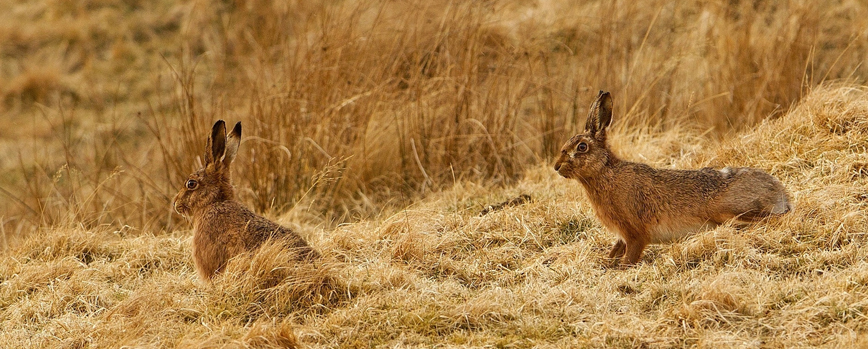
The hare lives nearly everywhere on the entire planet. Its most favoured locations are lowlands and uplands in warm areas, also changing crop fields and small woods. We used to have a high amount of hare in our country about 30 years backwards, ever since that time their number has decreased to around 215 thousand, which is only one tenth of the previous amount. The colouring of the hare is adjusted to its living environment. It has a brown yellowish underfur and the ends of its brown fur are black. The ventral side of the hare is white. Its short tail is black from the upper and white from the bottom side. It has an egg-shaped head with big eyes, which allow the hare to see backwards as well without rotating its head. The fully grown hare’s length is about 75 cm’s together with its tail and its weight varies from 4 to maximum of 5 kg. The difference between genders cannot be seen. It copulates 3 to 4 times a year – from February to July. At this time even during the day, one female is chased by many male hares. The males usually fight each other in a way that they stand up on their rear legs and they whack each other with their front legs.
Ring-necked Pheasant (Phasianus colchicus)
| Hunting Season: | Rooster (Male): 1.11. – 15.1. | Hen Pheasant (Female): 1.10. – 28.2. (only during joint group hunts) |
| Mating Season – Pheasant pairing season: | approx.: 1.4. – 30.4. |
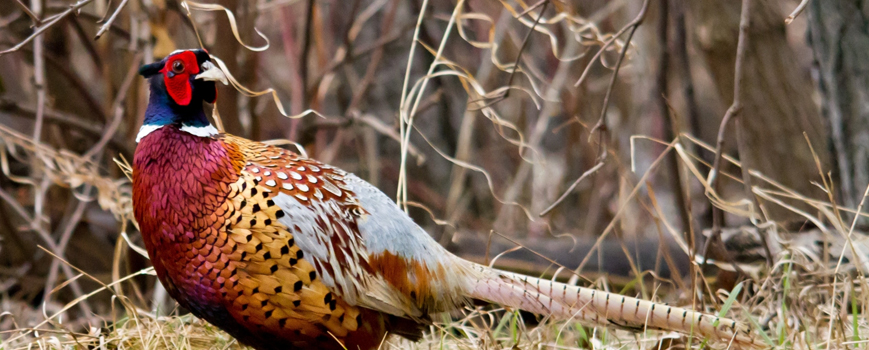
Pheasants live in Slovakia as in an agricultural country in the lowlands and in the warm uplands with enough of wood and hedges. Separately they favour broad-leaved forests with bushy underwood, overgrown wet shores of streams and swamps, where they can find enough of food for themselves. The pheasants of all of these races have a typical colourful tint, extended tail and red warted bald spots around their eyes, which are separately noticeable while they render the mating call. The weight of our pheasants reach up to 2 kg. The hen pheasants are smaller with an inconspicuous sand brown colouring with dark waves and short tail. The actual number of pheasants in our country is around 160 thousand. The lekking or mating season of the pheasants starts in the end of March. At this time the pheasants occupy their lekking spots, they run around and keep jumping around with their puffed-out feathers, while they keep flapping with their wings and they resound with a typical crowing voice. The pheasant protects its lekking spot from incoming rivals. The hen pheasants come to the lekking spots of the pheasants and the hens notify the pheasants with whistles.
Harmful Animals
Into this category we place animals, which are not beneficial neither for hunting and neither generally. Every type of harmful animal is hunted during the whole year and can be found predominantly on the entire region of our country.
Red fox (Vulpes vulpes)

Raccoon(Procyon lotor)
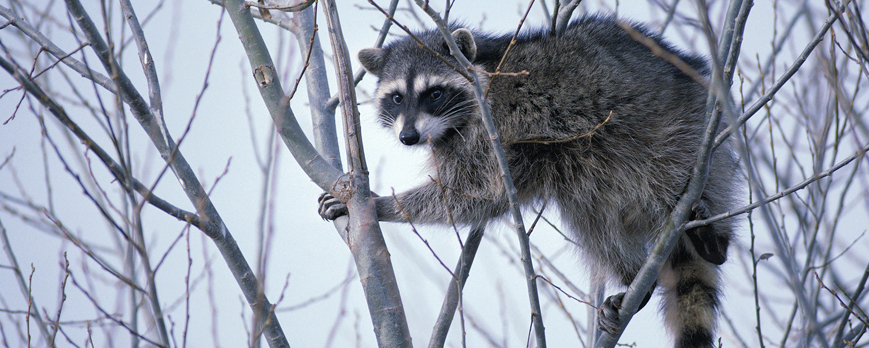
Raccoon dog (Nyctereutes procyonoides)
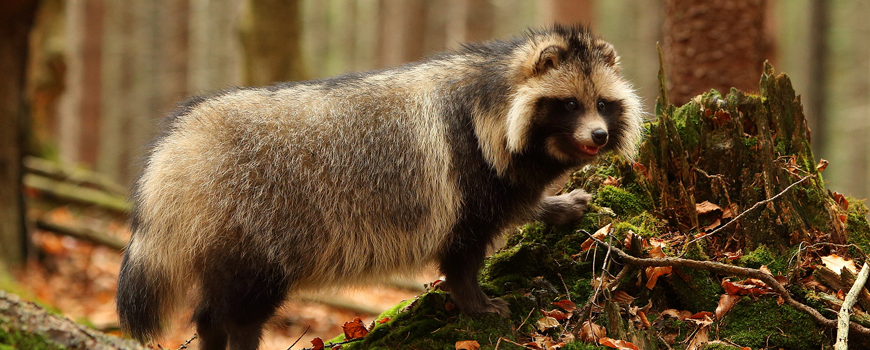
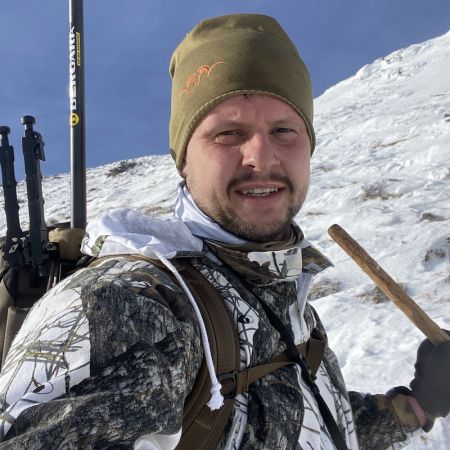
Dear hunters,
From my experience,
I know that true hunters come to hunt for adventure.
The trophy on the wall is just the tip of the iceberg in the sea, underneath which hide memories, adventures, and an unforgettable story.
Tomáš Melich
CEO / executive manager
Slovakia - heart of Europe
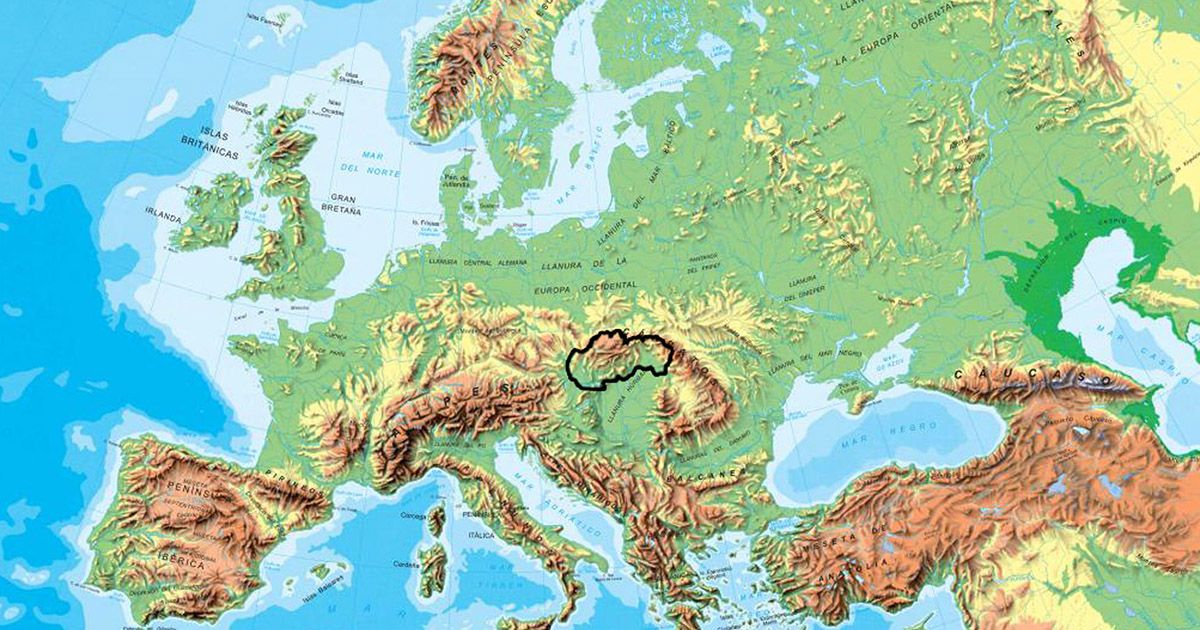
Overview of hunting
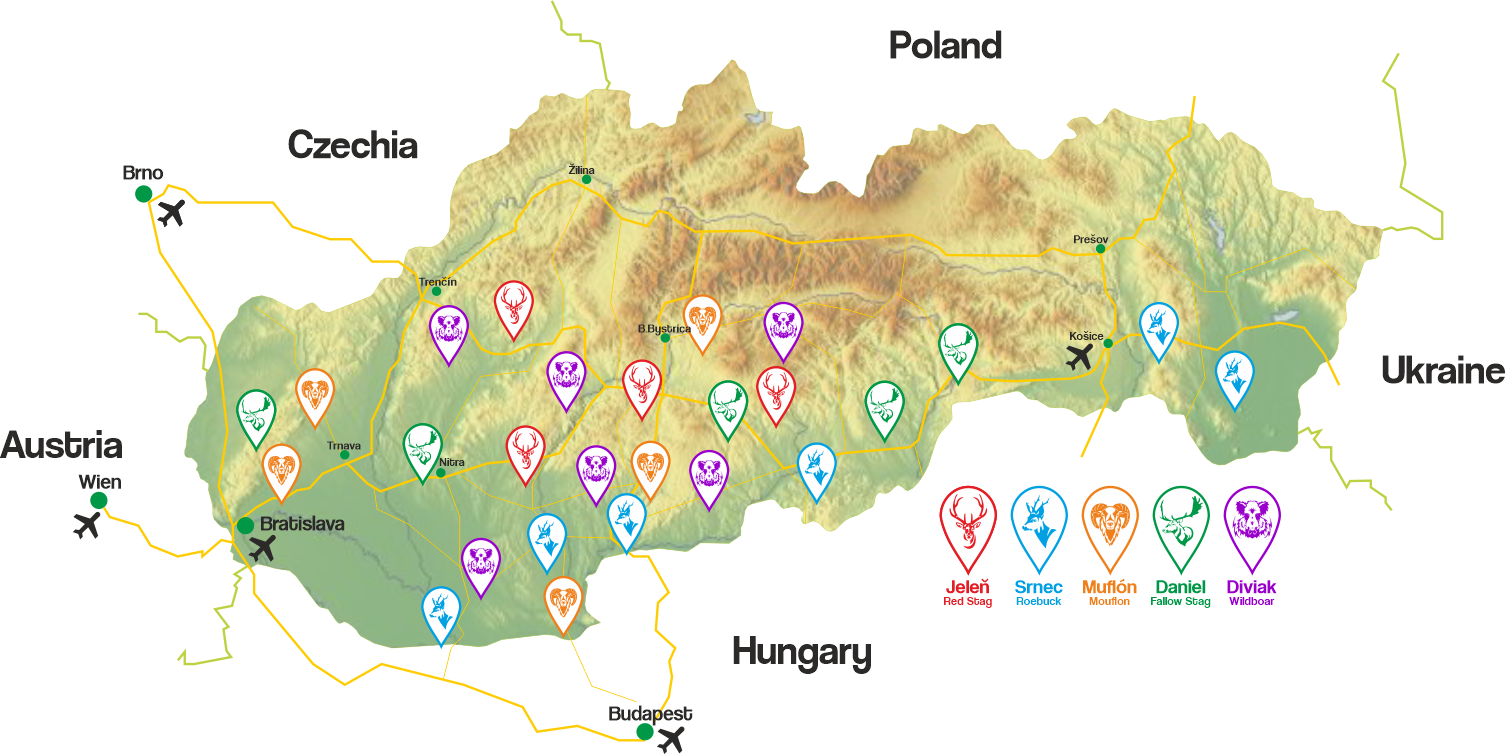
Exclusive partners




